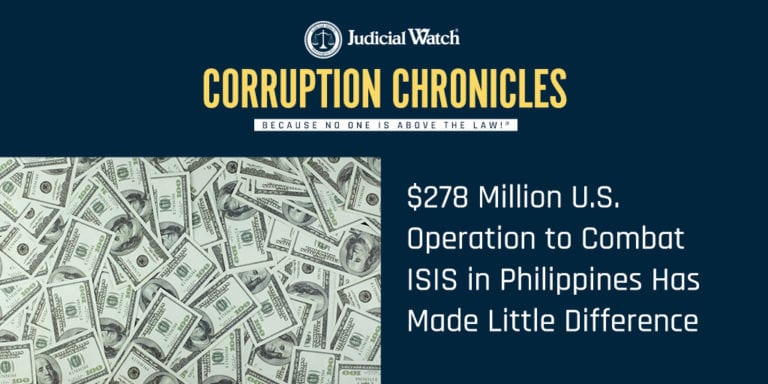

$278 Million U.S. Operation to Combat ISIS in Philippines Has Made Little Difference


The U.S. government has invested hundreds of millions of taxpayer dollars and other valuable military resources on a failed initiative to help the Philippines combat terrorism and the money and equipment keep flowing. The program is known as Operation Pacific Eagle–Philippines (OPE-P) and its goal is to rid the impoverished southeast Asian country of a growing force of Islamic extremists. Known as Islamic State of Iraq and Syria-East Asia (ISIS-EA), the Philippine faction of the terrorist group is rooted in the southern region and has carried out a multitude of attacks throughout the country. Despite years-long U.S. intervention, there has been little change in the terrorist group’s capabilities, size, financing, and operations, according to a Pentagon report.
The U.S. has wasted substantial resources to train Philippine forces and provide them with the materials necessary to deal with ISIS-EA operatives, but the effort has been largely futile, the Department of Defense (DOD) Inspector General writes in the 56-page report to Congress. So far this year the U.S. spent $70 million on OPE-P despite its well-documented failures. Last year American taxpayers doled out $108 million, Pentagon figures show, and the year before north of $100 million. “In general, efforts to reduce extremism in the Philippines do not appear to have made a substantial difference,” the DOD IG writes. The extensive document further states that ISIS-EA and its terrorist associates “have remained about the same size and strength for the last few years” with “little change” in the jihadists’ ability to finance and carry out attacks.
OPE-P was launched in 2017 as an overseas contingency operation by the Secretary of Defense and is carried out by the U.S. Indo-Pacific Command in coordination with other American government agencies. The goal is to provide the overwhelmed Philippine military forces with resources to counter ISIS affiliates and other violent extremist organizations. A big chunk of the U.S. money has funded intelligence, surveillance and reconnaissance operations, the report says. That includes costly military equipment such as drones to assist soldiers in capturing terrorists. Despite all of Uncle Sam’s help, the DOD estimates that 300 to 500 ISIS terrorists continue to commit acts of violence in the Philippines. In mid-April 40 militants ambushed Armed Forces of the Philippines (AFP) soldiers, killing 12 and wounding 13. The Defense Intelligence Agency (DIA) describes it as the “deadliest incident” involving Islamic terrorists since a 2019 suicide bombing that killed 23 and wounded more than 100 at a cathedral in Jolo, an island in the southwest.
“While ISIS-EA carried out its most deadly attack in 15 months, levels of violence in the Philippines were similar to previous quarters,” the DOD IG report says, adding that previous investigations have reached similar conclusions. “There has been little change in the capabilities, size, financing, and operations of ISIS-EA” since 2018, the watchdog writes. “The group continues to carry out sporadic, mostly small-scale attacks.” Investigators confirm that “ISIS-EA and the other violent extremist groups in the Philippines that either coordinate with or share members with ISIS, have remained about the same size and strength for the last few years.” The American taxpayer dollars and other relevant resources will keep flowing, however. The watchdog report confirms that the AFP, with the support from the United States, will continue to conduct counterterrorism operations to keep ISIS-EA from spreading and that the Philippines “continues to rely on U.S-provided intelligence, air assets, and other support to conduct counterterrorism operations.”
The report also touches on two factors evidently beyond U.S. control that are currently strengthening terrorist cells in the Philippines, even as American aide keeps pouring in. The first is COVID-19, which has forced the implementation of restrictions and force rotations that negatively impact the amount of U.S. intelligence, surveillance and reconnaissance support. The other is the release of around 10,000 jailed criminals to curb the spread of COVID-19 in one of the world’s most overcrowded prison systems. U.S. authorities believe many of the freed convicts incarcerated throughout the Philippines sympathize with ISIS and will join the terrorist cause. Many were recruited by ISIS-EA while in prison, according to Defense investigators.














